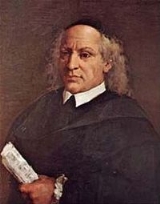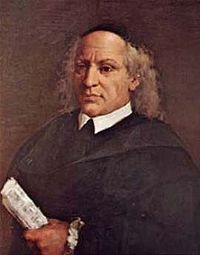
Leonardo Vinci
Encyclopedia
Leonardo Vinci was an Italian
composer
, best known for his opera
s.
 He was born at Strongoli
He was born at Strongoli
(or Naples
) and educated at Naples
under Gaetano Greco
in the Conservatorio dei Poveri di Gesù Cristo
. He first became known for his opere buffe
in Neapolitan dialect
in 1719; he also composed many opere serie
. He was received into the Congregation of the Rosary at Formiello in 1728. He died in May of 1730. Vinci is rumoured to have been poison
ed in the wake of an ill-advised affair.
Vinci's opere buffe, of which Li zite 'ngalera
(1722) is generally regarded as the best, are full of life and spirit; his opera seria, of which Didone Abbandonata (Rome, 1728) and Artaserse (Rome, 1730) are the most notable, have an incisive vigour and directness of dramatic expression praised by Charles Burney
. The well-known aria "Vo solcando," from Artaserse, is a good example of his style.
In addition to operas, Vinci wrote a few cantatas, sonatas, a serenata, and two oratorios (Oratorio di Maria dolorata ca. 1723 & Oratorio per la Santissima Vergine del Rosario ca. 1730). His sonata in B major for flute and basso continuo is still played today.
This entry was originally from the 1911 Encyclopedia Britannica.
Italy
Italy , officially the Italian Republic languages]] under the European Charter for Regional or Minority Languages. In each of these, Italy's official name is as follows:;;;;;;;;), is a unitary parliamentary republic in South-Central Europe. To the north it borders France, Switzerland, Austria and...
composer
Composer
A composer is a person who creates music, either by musical notation or oral tradition, for interpretation and performance, or through direct manipulation of sonic material through electronic media...
, best known for his opera
Opera
Opera is an art form in which singers and musicians perform a dramatic work combining text and musical score, usually in a theatrical setting. Opera incorporates many of the elements of spoken theatre, such as acting, scenery, and costumes and sometimes includes dance...
s.

Strongoli
Strongoli is a comune and town with a population of over 6000 people in the province of Crotone, in Calabria, Italy.-History:In antiquity, Strongoli was the site of Petelia, said to have been founded by Philoctetes....
(or Naples
Naples
Naples is a city in Southern Italy, situated on the country's west coast by the Gulf of Naples. Lying between two notable volcanic regions, Mount Vesuvius and the Phlegraean Fields, it is the capital of the region of Campania and of the province of Naples...
) and educated at Naples
Naples
Naples is a city in Southern Italy, situated on the country's west coast by the Gulf of Naples. Lying between two notable volcanic regions, Mount Vesuvius and the Phlegraean Fields, it is the capital of the region of Campania and of the province of Naples...
under Gaetano Greco
Gaetano Greco
- External links :...
in the Conservatorio dei Poveri di Gesù Cristo
Music Conservatories of Naples
The Music Conservatory of Naples is a music institution in Naples, southern Italy. It is currently located in the complex of San Pietro a Majella.-San Pietro a Majella:...
. He first became known for his opere buffe
Opera buffa
Opera buffa is a genre of opera. It was first used as an informal description of Italian comic operas variously classified by their authors as ‘commedia in musica’, ‘commedia per musica’, ‘dramma bernesco’, ‘dramma comico’, ‘divertimento giocoso' etc...
in Neapolitan dialect
Neapolitan language
Neapolitan is the language of the city and region of Naples , and Campania. On October 14, 2008 a law by the Region of Campania stated that the Neapolitan language had to be protected....
in 1719; he also composed many opere serie
Opera seria
Opera seria is an Italian musical term which refers to the noble and "serious" style of Italian opera that predominated in Europe from the 1710s to c. 1770...
. He was received into the Congregation of the Rosary at Formiello in 1728. He died in May of 1730. Vinci is rumoured to have been poison
Poison
In the context of biology, poisons are substances that can cause disturbances to organisms, usually by chemical reaction or other activity on the molecular scale, when a sufficient quantity is absorbed by an organism....
ed in the wake of an ill-advised affair.
Vinci's opere buffe, of which Li zite 'ngalera
Li zite 'ngalera
Li zite 'ngalera is a commedia per musica in three acts by the Italian composer Leonardo Vinci. The libretto, by Bernardo Saddumene, is written in Neapolitan dialect...
(1722) is generally regarded as the best, are full of life and spirit; his opera seria, of which Didone Abbandonata (Rome, 1728) and Artaserse (Rome, 1730) are the most notable, have an incisive vigour and directness of dramatic expression praised by Charles Burney
Charles Burney
Charles Burney FRS was an English music historian and father of authors Frances Burney and Sarah Burney.-Life and career:...
. The well-known aria "Vo solcando," from Artaserse, is a good example of his style.
Operas
- Le doje lettere (1719)
- Lo cecato fauzo (1719)
- Lo scagno (1720)
- Lo scassone (1720)
- Lo Barone di Trocchia (1721)
- Don Ciccio (1721)
- Li zite 'ngaleraLi zite 'ngaleraLi zite 'ngalera is a commedia per musica in three acts by the Italian composer Leonardo Vinci. The libretto, by Bernardo Saddumene, is written in Neapolitan dialect...
(1722) - La festa di Bacco (1722)
- Publio Cornelio Scipione (1722)
- Lo castiello sacchiato (1722)
- Lo labberinto (1723)
- Semiramide (1723)
- Partenope (1723)
- Silla dittatore (1723)
- Farnace (1724)
- La mogliera fedele (1724)
- Turno Aricino (1724)
- Ifigenia in Tauride (1725)
- La Rosmira fedele (1725)
- Il trionfo di Camilla (1725)
- Elpidia (1725)
- L'Astianatte (1725)
- Didone abbandonata (1726)
- Siroe, Re di Persia (1726)
- L'asteria (1726)
- Ernelinda (1726)
- Gismondo, Re di Polonia (1727)
- La caduta dei Decemviri (1727)
- Catone in Utica (1728)
- Medo (1728)
- Flavio Anicio Olibrio (1728 )
- La Semiramide riconosciuta (1729 )
- Alessandro nell'Indie (1729)
- Farnace (1729)
- La Contesa dei Numi (1729)
- Massimiano (1729)
- Artaserse (1730)
In addition to operas, Vinci wrote a few cantatas, sonatas, a serenata, and two oratorios (Oratorio di Maria dolorata ca. 1723 & Oratorio per la Santissima Vergine del Rosario ca. 1730). His sonata in B major for flute and basso continuo is still played today.
Sources
This entry was originally from the 1911 Encyclopedia Britannica.

